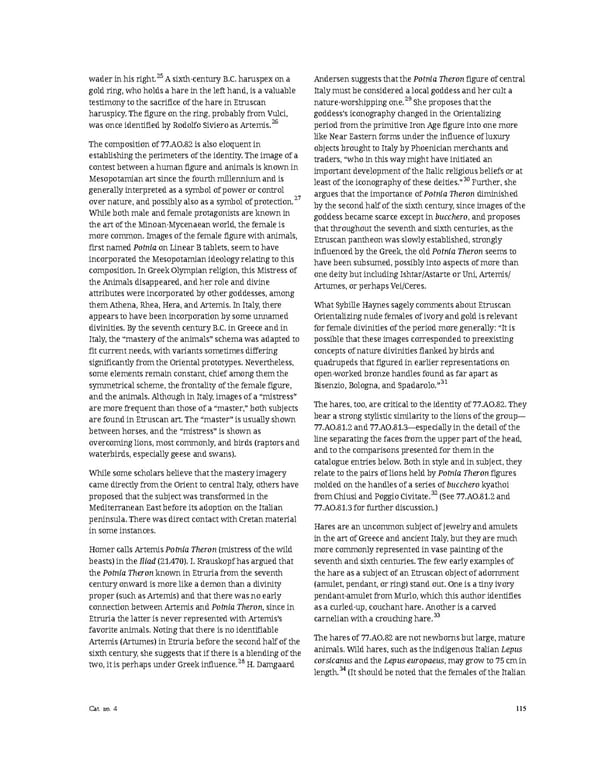wader in his right.25 A sixth-century B.C. haruspex on a Andersen suggests that the Potnia Theron figure of central gold ring, who holds a hare in the left hand, is a valuable Italy must be considered a local goddess and her cult a testimony to the sacrifice of the hare in Etruscan nature-worshipping one.29 She proposes that the haruspicy. The figure on the ring, probably from Vulci, goddess’s iconography changed in the Orientalizing was once identified by Rodolfo Siviero as Artemis.26 period from the primitive Iron Age figure into one more like Near Eastern forms under the influence of luxury The composition of 77.AO.82 is also eloquent in objects brought to Italy by Phoenician merchants and establishing the perimeters of the identity. The image of a traders, “who in this way might have initiated an contest between a human figure and animals is known in important development of the Italic religious beliefs or at Mesopotamian art since the fourth millennium and is least of the iconography of these deities.”30 Further, she generally interpreted as a symbol of power or control argues that the importance of Potnia Theron diminished over nature, and possibly also as a symbol of protection.27 by the second half of the sixth century, since images of the While both male and female protagonists are known in goddess became scarce except in bucchero, and proposes the art of the Minoan-Mycenaean world, the female is that throughout the seventh and sixth centuries, as the more common. Images of the female figure with animals, Etruscan pantheon was slowly established, strongly first named Potnia on Linear B tablets, seem to have influenced by the Greek, the old Potnia Theron seems to incorporated the Mesopotamian ideology relating to this have been subsumed, possibly into aspects of more than composition. In Greek Olympian religion, this Mistress of one deity but including Ishtar/Astarte or Uni, Artemis/ the Animals disappeared, and her role and divine Artumes, or perhaps Vei/Ceres. attributes were incorporated by other goddesses, among them Athena, Rhea, Hera, and Artemis. In Italy, there What Sybille Haynes sagely comments about Etruscan appears to have been incorporation by some unnamed Orientalizing nude females of ivory and gold is relevant divinities. By the seventh century B.C. in Greece and in for female divinities of the period more generally: “It is Italy, the “mastery of the animals” schema was adapted to possible that these images corresponded to preexisting fit current needs, with variants sometimes differing concepts of nature divinities flanked by birds and significantly from the Oriental prototypes. Nevertheless, quadrupeds that figured in earlier representations on some elements remain constant, chief among them the open-worked bronze handles found as far apart as symmetrical scheme, the frontality of the female figure, Bisenzio, Bologna, and Spadarolo.”31 and the animals. Although in Italy, images of a “mistress” are more frequent than those of a “master,” both subjects The hares, too, are critical to the identity of 77.AO.82. They are found in Etruscan art. The “master” is usually shown bear a strong stylistic similarity to the lions of the group— between horses, and the “mistress” is shown as 77.AO.81.2 and 77.AO.81.3—especially in the detail of the overcoming lions, most commonly, and birds (raptors and line separating the faces from the upper part of the head, waterbirds, especially geese and swans). and to the comparisons presented for them in the catalogue entries below. Both in style and in subject, they While some scholars believe that the mastery imagery relate to the pairs of lions held by Potnia Theron figures came directly from the Orient to central Italy, others have molded on the handles of a series of bucchero kyathoi proposed that the subject was transformed in the from Chiusi and Poggio Civitate.32 (See 77.AO.81.2 and Mediterranean East before its adoption on the Italian 77.AO.81.3 for further discussion.) peninsula. There was direct contact with Cretan material in some instances. Hares are an uncommon subject of jewelry and amulets in the art of Greece and ancient Italy, but they are much Homer calls Artemis Potnia Theron (mistress of the wild more commonly represented in vase painting of the beasts) in the Iliad (21.470). I. Krauskopf has argued that seventh and sixth centuries. The few early examples of the Potnia Theron known in Etruria from the seventh the hare as a subject of an Etruscan object of adornment century onward is more like a demon than a divinity (amulet, pendant, or ring) stand out. One is a tiny ivory proper (such as Artemis) and that there was no early pendant-amulet from Murlo, which this author identifies connection between Artemis and Potnia Theron, since in as a curled-up, couchant hare. Another is a carved Etruria the latter is never represented with Artemis’s carnelian with a crouching hare.33 favorite animals. Noting that there is no identifiable Artemis (Artumes) in Etruria before the second half of the The hares of 77.AO.82 are not newborns but large, mature sixth century, she suggests that if there is a blending of the animals. Wild hares, such as the indigenous Italian Lepus two, it is perhaps under Greek influence.28 H. Damgaard corsicanus and the Lepus europaeus, may grow to 75 cm in length.34 (It should be noted that the females of the Italian Cat. no. 4 115
 Ancient Carved Ambers in the J. Paul Getty Museum Page 124 Page 126
Ancient Carved Ambers in the J. Paul Getty Museum Page 124 Page 126